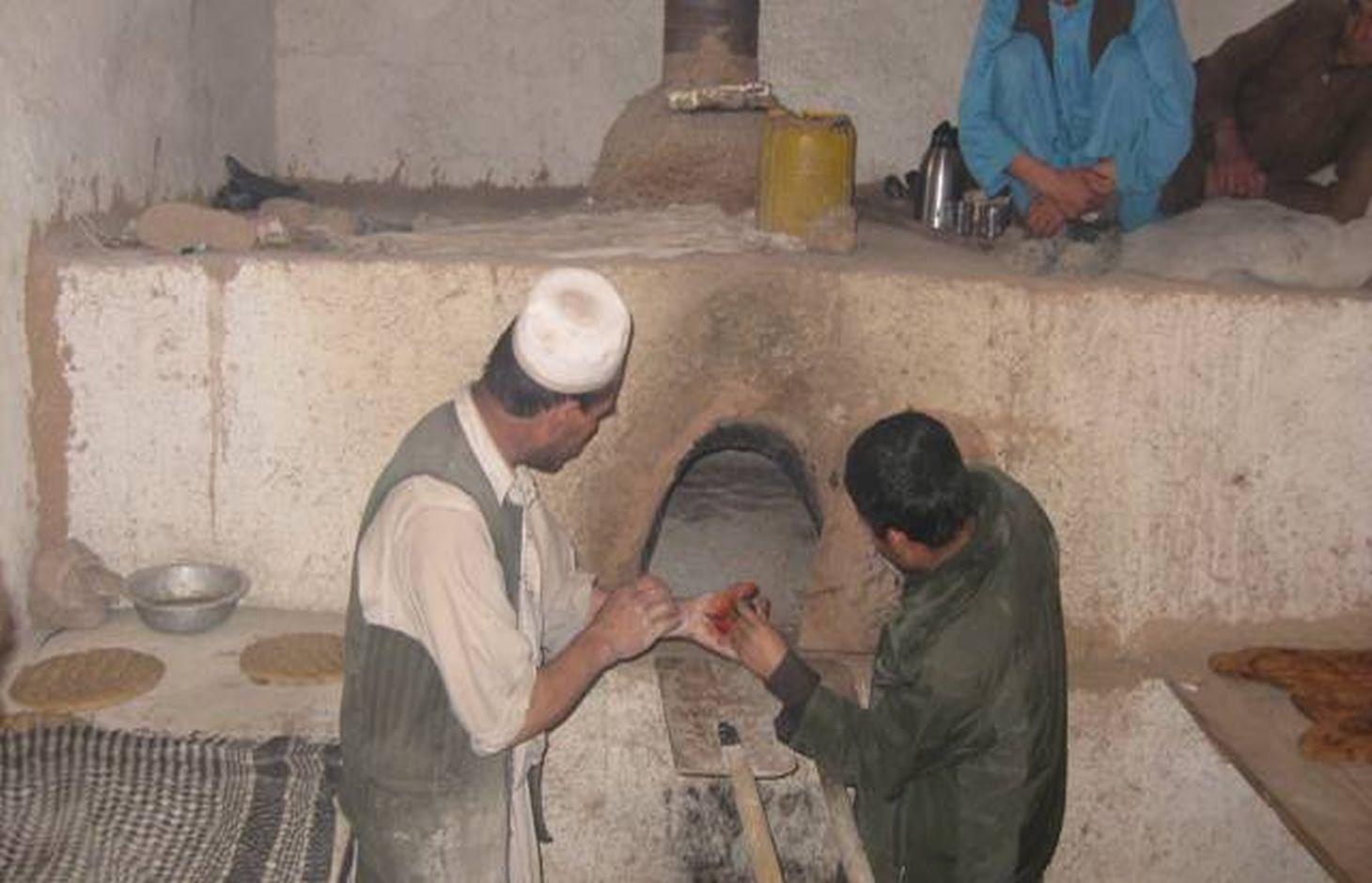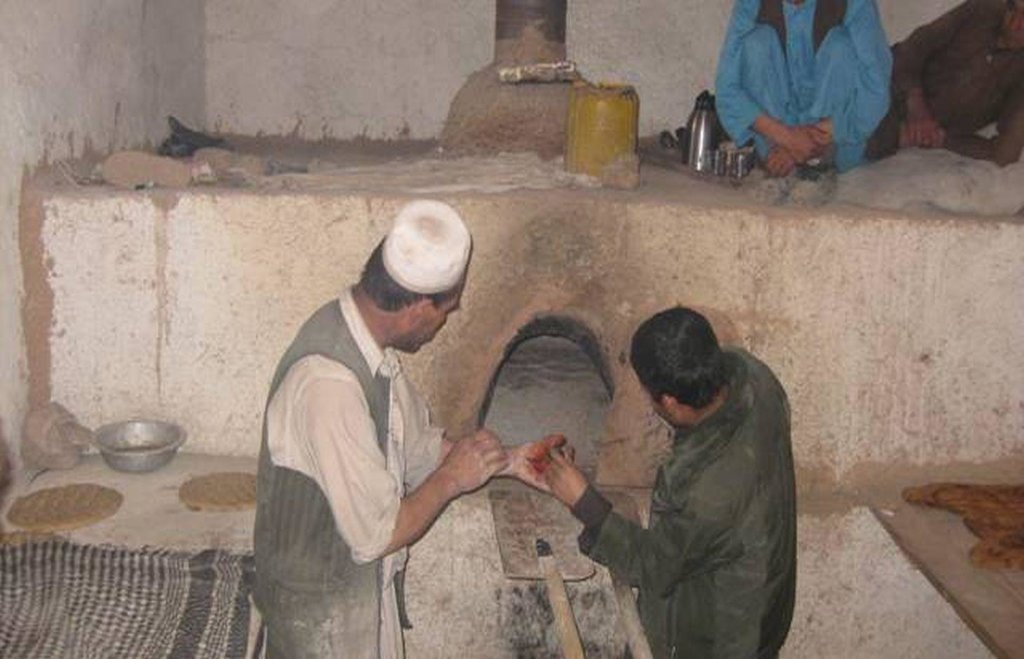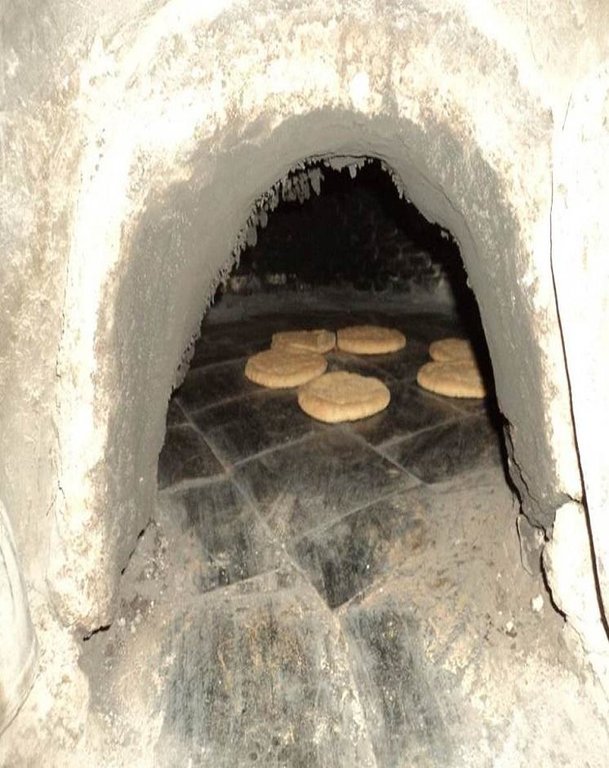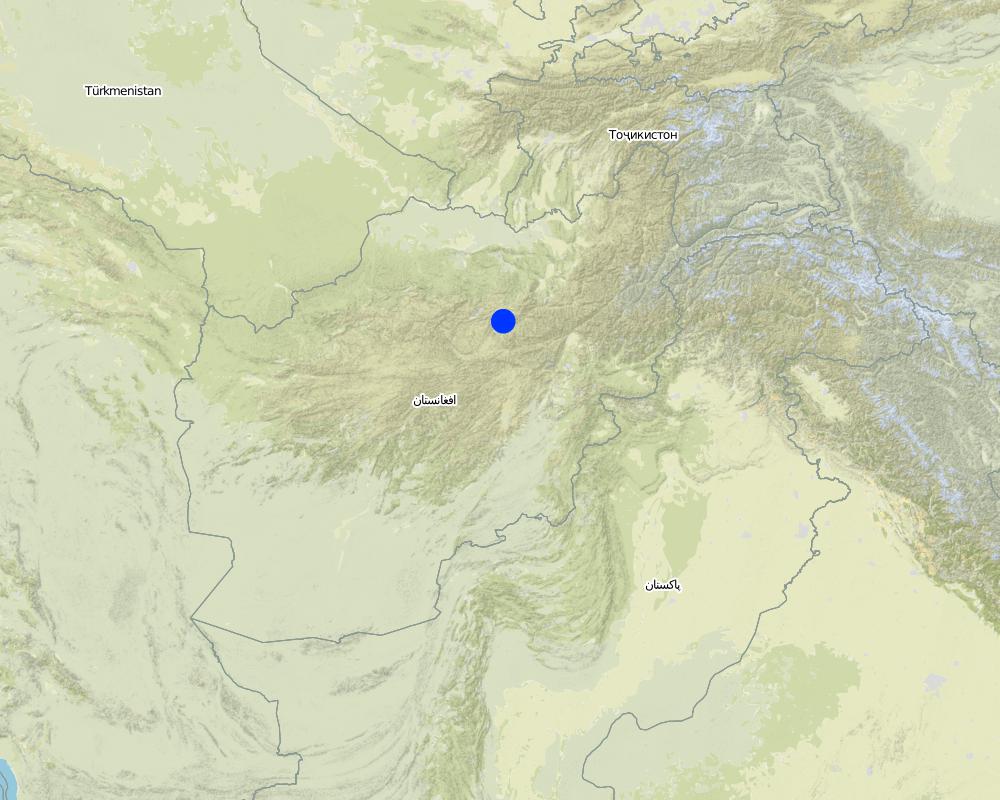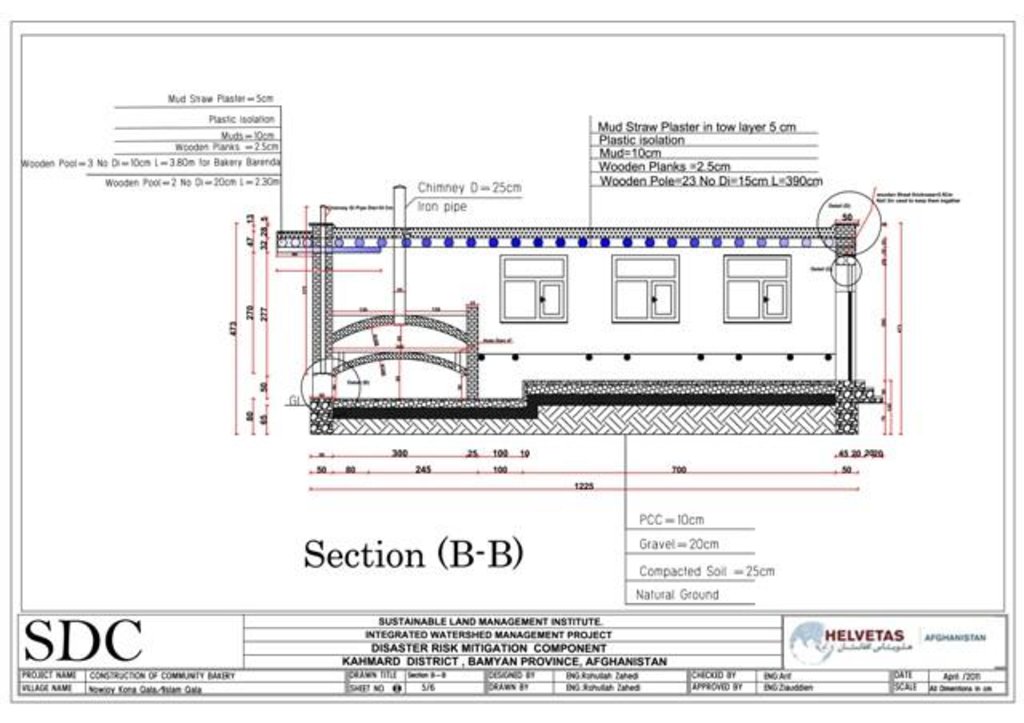Community bakery [阿富汗]
- 创建:
- 更新:
- 编制者: Aqila Haidery
- 编辑者: –
- 审查者: Deborah Niggli, Joana Eichenberger
Dash Nanboe (Dari)
technologies_1718 - 阿富汗
查看章节
全部展开 全部收起1. 一般信息
1.2 参与该技术评估和文件编制的资源人员和机构的联系方式
SLM专业人员:
Homayoun Ashraf
HELVETAS Swiss Intercooperation
阿富汗
SLM专业人员:
Ahmad Ali Sediqi
HELVETAS Swiss Intercooperation
阿富汗
有助于对技术进行记录/评估的机构名称(如相关)
HELVETAS (Swiss Intercooperation)1.3 关于使用通过WOCAT记录的数据的条件
编制者和关键资源人员接受有关使用通过WOCAT记录数据的条件。:
是
1.4 所述技术的可持续性声明
这里所描述的技术在土地退化方面是否存在问题,导致无法被认为是一种可持续的土地管理技术?:
否
2. SLM技术的说明
2.1 技术简介
技术定义:
A sustainable option for bread baking and reducing shrub consumption
2.2 技术的详细说明
说明:
Thirty six community bakeries were constructed in Kahmard from 2009-2012 for reducing shrub consumption. Rural communities normally bake bread at home using tandoors made from clay and fired by shrubs, wood and coal. Bread baking is a demanding task. Men and boys climb mountains to collect shrubs, putting themselves at risk, and women spend 1-2 hours/day for preparing dough, firing the oven and baking bread. Shrub cutting causes upland degradation leading to flash floods in the valleys.
In Saighan, district adjoining Kahmard, a survey showed that one household uses 81 donkey load shrubs annually, and minimum 50 donkey loads are used for baking bread. Kahmard has a similar situation. To address this, HELVETAS Swiss Intercooperation is supporting an integrated watershed management in Kahmard since 2008 with support from the Swiss Re and Swiss Agency for Development and Cooperation (SDC). The approach comprises other technological and organisational measures where structural and vegetative are applied, combined with grazing and shrub cutting control. To complement re-greening efforts, energy efficient community bakeries were promoted.
Households using community bakeries reported a decrease in shrub consumption by 50-80%, which contributes to greener watersheds. The other benefits include more time for women, boys and girls for other preferred activities, like attending school, literacy classes, vocational trainings, embroidery, etc. Families also save money (minimum US$ 10/month) as they have to purchase less shrubs for baking purpose. In Kahmard, one donkey load shrub costs about US$ 6. Bakers, assistant bakers, masons and workers are employed and bakeries serve as a place for social networking. By contributing to greener watersheds, the bakeries help to reduce flash flood risks. In recent months, running the bakeries has become a challenge as the coal mines in Kahmard have been contracted to a Chinese firm. As a consequence, people are not getting coal easily. Due to coal shortages, several bakeries have stopped functioning. People are looking towards the government authorities to solve this issue as soon as possible. Many households have gone back to shrub cutting and a community assets with proven benefits for the people but environment remains underutilized.
The participating community development councils or CDCs allocate land for bakery. One bakery costs about US$ 4640, with 25% community contribution during construction. It takes about 5 weeks for constructing one bakery if there are no obstacles. About US$ 7300/year is spent on operation and maintenance by the people. One baker and 1-2 assistants are employed for daily bakery operations. The dash or oven is prepared from a mixture of clay and sheep hair and fired by coal. About 1-3 bags are required per day. If mosaic tiles are used, about 1 bag per day is used for heating. The factors influencing the success of community bakeries include access to coal, good quality and low price of coal, on time payment and proper management of bakery funds. The clients bring dough from home and pay about US$ 0.042 (2 Afghani) per bread to the baker or about US$ 6.6/month.
Community bakeries were constructed in the Kahmard district in the valley bottoms where the people reside. The land for community bakeries normally belongs to the community, but where suitable common land is not available, individuals have also donated their private lands for the common cause.
Community bakeries are located at an altitude of about 1700-1800 m above mean sea level. The district receives up to 400 mm rainfall in a good year. In the valley bottom, there are crop growing seasons, the main is from March to July. The land users rely mainly on agriculture for their livelihoods as employment opportunities in the district are very few. Kahmard district has a population density of about 30 person/sq. km. About 50% of the rural population in Kahmard falls under poor category, 40% are medium rich and 10% rich.
2.3 技术照片
2.5 已应用该技术的、本评估所涵盖的国家/地区/地点
国家:
阿富汗
区域/州/省:
Bamyan Province
有关地点的进一步说明:
Kahmard district
具体说明该技术的分布:
- 均匀地分布在一个区域
如果不知道精确的区域,请注明大致覆盖的区域:
- < 0.1 平方千米(10 公顷)
注释:
Each bakery has an area of about 58 sq. m, and 25 bakeries have been constructed so far in Kahmard district with HELVETAS Swiss Intercooperation support and financial contributions from the Swiss Agency for Development and Cooperation (SDC).
Map
×2.6 实施日期
如果不知道确切的年份,请说明大概的日期:
- 不到10年前(最近)
2.7 技术介绍
详细说明该技术是如何引入的:
- 通过项目/外部干预
注释(项目类型等):
The first community bakery in Kahmard district was constructed in 2009 with HELVETAS Swiss Intercooperation support. Since then, 25 bakeries have been constructed as a complementary watershed management technology.
3. SLM技术的分类
3.2 应用该技术的当前土地利用类型

定居点、基础设施
- Community bakeries

不毛之地
具体说明:
Wastelands, deserts, glaciers, swamps, recreation areas, etc before Technology, settlements, infrastructure networks afterwards.
注释:
Major land use problems (compiler’s opinion): Severe flash floods due to degradation of upland watersheds as a result of overgrazing, shrub uprooting, ploughing and recurring droughts. There is a lack of organizational capacities for sustainable management of land and water resources.
Major land use problems (land users’ perception): Severe flash floods due to watershed degradation resulting in destruction of property and life. Lack of knowledge about disaster risk mitigation. Lack of alternatives to fuel wood, especially for bread baking and house warming.
Future (final) land use (after implementation of SLM Technology): Other: Os: Settlements, infrastructure networks
Constraints of settlement / urban: Some areas are not fully utilized. Some are vulnerable to flash floods.
Number of growing seasons per year: 2
Longest growing period in days: 150, Longest growing period from month to month: March to July, Second longest growing period in days: 90, Second longest growing period from month to month: August to October
3.3 由于技术的实施,土地使用是否发生了变化?

不毛之地
具体说明:
Wastelands, deserts, glaciers, swamps, recreation areas, etc before Technology, settlements, infrastructure networks afterwards.
3.5 该技术所属的SLM组
- 畜牧业和牧场管理
- 改良的地面/植被覆盖
3.6 包含该技术的可持续土地管理措施

结构措施
- S11:其它
3.7 该技术强调的主要土地退化类型

土壤水蚀
- Wt:表土流失/地表侵蚀
- Wg:冲沟侵蚀/沟蚀

生物性退化
- Bc:植被覆盖的减少
注释:
Main causes of degradation: over-exploitation of vegetation for domestic use (extraction of shrubs for fuelwood), overgrazing (Overgrazing by sheep and goats), disturbance of water cycle (infiltration / runoff) (Due to biological degradation), droughts (Recurring droughts slow down vegetation recovery), land tenure (If it was private land, degradation extent would have been much less), governance / institutional (There is no legal and institutional set up for community based natural resource management)
Secondary causes of degradation: deforestation / removal of natural vegetation (incl. forest fires) (Removal of Juniper trees during war period), other natural causes (avalanches, volcanic eruptions, mud flows, highly susceptible natural resources, extreme topography, etc.) specify (Some grazed areas are very steep), population pressure (Due to increasing population, there is increasing pressure on natural resources), poverty / wealth (People depend on livestock. There is lack of off-farm employment opportunities), war and conflicts (During war, traditional NRM systems also collapsed)
3.8 防止、减少或恢复土地退化
具体数量名该技术与土地退化有关的目标:
- 减少土地退化
- 修复/恢复严重退化的土地
4. 技术规范、实施活动、投入和成本
4.1 该技术的技术图纸
技术规范(与技术图纸相关):
A detailed technical drawing (long section) of a community bakery in Kahmard district supported by HELVETAS Swiss Intercoop-eration with the dome shaped oven or dash.
Location: Nowjoy Kona Qala. Kahmard district/Bamyan province
Date: 04/2009
Technical knowledge required for field staff / advisors: moderate (The community bakery was designed by Engineers of HELVETAS Swiss Intercooperation)
Technical knowledge required for land users: high (Construction of dash requires high technical knowledge. There are however some very skilled people in the community who know the art of making dash.)
Main technical functions: improvement of ground cover, increase of infiltration, Reduces people's dependency on shrubs, which are extracted from the upland watersheds
Structural measure: Community Bakery
Height of bunds/banks/others (m): 4.75
Width of bunds/banks/others (m): 7.45
Length of bunds/banks/others (m): 12.5
Construction material (earth): Soil/clay/sand
Construction material (stone): stones for foundation/bricks (sun dried)
Construction material (wood): Poles for roof beams, doors, windows
Construction material (concrete): cement, gypsum
Construction material (other): hair for dash
作者:
Eng. Rohullah Zahedi, HELVETAS Swiss Intercooperation, Afghanistan
4.2 有关投入和成本计算的一般信息
其它/国家货币(具体说明):
Afghani
如相关,注明美元与当地货币的汇率(例如1美元=79.9巴西雷亚尔):1美元=:
50.0
注明雇用劳工的每日平均工资成本:
5.00
4.3 技术建立活动
| 活动 | 时间(季度) | |
|---|---|---|
| 1. | Construction of community bakery as per technical design and based on feasibility study | Five months |
4.4 技术建立所需要的费用和投入
| 对投入进行具体说明 | 单位 | 数量 | 单位成本 | 每项投入的总成本 | 土地使用者承担的成本% | |
|---|---|---|---|---|---|---|
| 劳动力 | 1.0 | 1223.0 | 1223.0 | 10.0 | ||
| 设备 | Tools | 1.0 | 60.0 | 60.0 | 100.0 | |
| 施工材料 | Sand, soil, cement, gypsum, br | 1.0 | 3356.0 | 3356.0 | 30.0 | |
| 技术建立所需总成本 | 4639.0 | |||||
| 技术建立总成本,美元 | 92.78 | |||||
注释:
Duration of establishment phase: 1.5 month(s)
4.5 维护/经常性活动
| 活动 | 时间/频率 | |
|---|---|---|
| 1. | Bakery operation (Baker and Assistant Baker salaries) | Year round |
| 2. | Roof plastering with clay and straw | Once before winter |
| 3. | Baking bread | Year round |
| 4. | Dash firing and heating | year round |
| 5. | Fire ignition | Year round |
4.6 维护/经常性活动所需要的费用和投入(每年)
| 对投入进行具体说明 | 单位 | 数量 | 单位成本 | 每项投入的总成本 | 土地使用者承担的成本% | |
|---|---|---|---|---|---|---|
| 劳动力 | 1.0 | 3600.0 | 3600.0 | 100.0 | ||
| 施工材料 | Roof plastering mud and straw | 1.0 | 38.5 | 38.5 | 100.0 | |
| 施工材料 | Coal | 1.0 | 3650.0 | 3650.0 | 100.0 | |
| 施工材料 | Tyre | 1.0 | 300.0 | 300.0 | 100.0 | |
| 施工材料 | Dash shovel | 1.0 | 10.0 | 10.0 | 100.0 | |
| 技术维护所需总成本 | 7598.5 | |||||
| 技术维护总成本,美元 | 151.97 | |||||
注释:
Machinery/ tools: Sand, Soil, cement, gypsum, bricks, stones, gravel, straw, plastic, clay, hair, wooden door, timber for beams, glass, paint, gutter pipes. Ventilation pipes
The costs in 2.6.1. relate to the construction, operation and maintenance of one community bakery. The estimates are based on the Bills of Quantity prepared in 2009.
4.7 影响成本的最重要因素
描述影响成本的最决定性因素:
Most of the expenses for construction work is on equipment and materials like shovels, pick axe, wheel barrow, wooden doors, timber beams, window, concrete bricks, and sun dried bricks. In terms of recurrent costs, most spending is on coal and on the salaries of the baker and assistant bakers.
5. 自然和人文环境
5.1 气候
年降雨量
- < 250毫米
- 251-500毫米
- 501-750毫米
- 751-1,000毫米
- 1,001-1,500毫米
- 1,501-2,000毫米
- 2,001-3,000毫米
- 3,001-4,000毫米
- > 4,000毫米
农业气候带
- 半干旱
Thermal climate class: temperate. The minimum temperature in Kahmard district can be up to -70°C.
5.2 地形
平均坡度:
- 水平(0-2%)
- 缓降(3-5%)
- 平缓(6-10%)
- 滚坡(11-15%)
- 崎岖(16-30%)
- 陡峭(31-60%)
- 非常陡峭(>60%)
地形:
- 高原/平原
- 山脊
- 山坡
- 山地斜坡
- 麓坡
- 谷底
垂直分布带:
- 0-100 m a.s.l.
- 101-500 m a.s.l.
- 501-1,000 m a.s.l.
- 1,001-1,500 m a.s.l.
- 1,501-2,000 m a.s.l.
- 2,001-2,500 m a.s.l.
- 2,501-3,000 m a.s.l.
- 3,001-4,000 m a.s.l.
- > 4,000 m a.s.l.
5.3 土壤
平均土层深度:
- 非常浅(0-20厘米)
- 浅(21-50厘米)
- 中等深度(51-80厘米)
- 深(81-120厘米)
- 非常深(> 120厘米)
土壤质地(表土):
- 中粒(壤土、粉土)
土壤质地(地表以下> 20厘米):
- 中粒(壤土、粉土)
表土有机质:
- 低(<1%)
5.4 水资源可用性和质量
地下水位表:
5-50米
地表水的可用性:
好
水质(未处理):
良好饮用水
关于水质和水量的注释和进一步规范:
When the water is fetched from wells or natural springs the water is good drinking water, otherwise it is poor drinking water (surface water, must be treated before consumption)
5.5 生物多样性
物种多样性:
- 低
5.6 应用该技术的土地使用者的特征
非农收入:
- 收入的10-50%
相对财富水平:
- 贫瘠
- 平均水平
个人或集体:
- 团体/社区
性别:
- 男人
说明土地使用者的其他有关特征:
Land users applying the Technology are mainly common / average land users
Difference in the involvement of women and men: Men are mostly involved in the construction and operation of the bakeries. However, in some areas women and girls bring pasta to the bakery for bread baking. Women's support for community bakeries is strong as they benefit directly .
Population density: 10-50 persons/km2
Annual population growth: 2% - 3%
10% of the land users are very rich.
40% of the land users are average wealthy.
50% of the land users are poor.
Off-farm income specification: Due to small land holding size, there is not enough income from the farmlands to support large families. Therefore, people rely on seasonal work opportunities either within the district or their communities or migrate to Afghan cities or neighboring countries for work. Some people work in coal mines which are present in the district.
5.7 应用该技术的土地使用者使用的平均土地面积
- < 0.5 公顷
- 0.5-1 公顷
- 1-2 公顷
- 2-5公顷
- 5-15公顷
- 15-50公顷
- 50-100公顷
- 100-500公顷
- 500-1,000公顷
- 1,000-10,000公顷
- > 10,000公顷
这被认为是小规模、中规模还是大规模的(参照当地实际情况)?:
- 中等规模的
5.8 土地所有权、土地使用权和水使用权
土地所有权:
- 社区/村庄
- 个人,有命名
土地使用权:
- 社区(有组织)
用水权:
- 社区(有组织)
注释:
Mostly, the land used for community bakeries belongs to the community. In case suitable land is not available, the community development council members and village elders motivate individuals to spare their land for the common cause.
5.9 进入服务和基础设施的通道
健康:
- 贫瘠
- 适度的
- 好
教育:
- 贫瘠
- 适度的
- 好
技术援助:
- 贫瘠
- 适度的
- 好
就业(例如非农):
- 贫瘠
- 适度的
- 好
市场:
- 贫瘠
- 适度的
- 好
能源:
- 贫瘠
- 适度的
- 好
道路和交通:
- 贫瘠
- 适度的
- 好
饮用水和卫生设施:
- 贫瘠
- 适度的
- 好
金融服务:
- 贫瘠
- 适度的
- 好
6. 影响和结论性说明
6.1 该技术的现场影响
社会经济效应
生产
木材生产
注释/具体说明:
This is due to less shrub extraction in the watersheds
能源生产
收入和成本
收入来源的多样性
注释/具体说明:
Some women have more time and can take part in off-farm income generation activities. e.g. embroidery.
其它社会经济效应
Air pollution
注释/具体说明:
Due to burning of coal.
Loss of income for shrub collectors
注释/具体说明:
Less demand for shrubs for fire wood.
社会文化影响
食品安全/自给自足
注释/具体说明:
Due to more savings, people can buy more food and reduce their food gaps.
健康状况
注释/具体说明:
Less exposure to smoke and heat.
文化机会
注释/具体说明:
More opportunities for social networking for men and women.
娱乐机会
注释/具体说明:
Especially for women as they have more time.
社区机构
注释/具体说明:
People cooperate with each other for running the bakeries. There are less conflicts over bread baking within the households. There is also more social networking as people meet more often at the bakeries when they bring dough.
SLM/土地退化知识
注释/具体说明:
People understand well the linkage between community bakeries, watershed management and flash flood risk mitigation.
冲突缓解
注释/具体说明:
Especially members of a family over bread baking or shrub collection.
生态影响
水循环/径流
地表径流
注释/具体说明:
Due to better vegetation cover in the watersheds.
土壤
土壤覆盖层
注释/具体说明:
Due to more shrubs in the watersheds.
生物多样性:植被、动物
生物量/地上C
注释/具体说明:
Due to increased shrub cover.
其它生态影响
energy generation (eg hydro, bio)
注释/具体说明:
Use of coal which is plenty available in the district due to presence of coal mines.
6.2 该技术的场外影响已经显现
下游洪水
注释/具体说明:
Due to more vegetation cover and increased infiltration.
对公共/私人基础设施的破坏
注释/具体说明:
Due to reduced flash floods,
6.3 技术对渐变气候以及与气候相关的极端情况/灾害的暴露和敏感性(土地使用者认为的极端情况/灾害)
渐变气候
渐变气候
| 季节 | 增加或减少 | 该技术是如何应对的? | |
|---|---|---|---|
| 年温度 | 增加 | 好 |
气候有关的极端情况(灾害)
气象灾害
| 该技术是如何应对的? | |
|---|---|
| 局地暴雨 | 不好 |
| 局地风暴 | 好 |
气候灾害
| 该技术是如何应对的? | |
|---|---|
| 干旱 | 好 |
水文灾害
| 该技术是如何应对的? | |
|---|---|
| 比较和缓的(河道)洪水 | 不好 |
其他气候相关的后果
其他气候相关的后果
| 该技术是如何应对的? | |
|---|---|
| 缩短生长期 | 好 |
注释:
If the weather gets too cold, more coal may be required for dash heating. There can be damages due to heavy rainfall but the bakeries can still operate. Therefore, it is not a major issue. Even without climatic extremes, the bakeries can be damaged due to flash floods.
Modifications possible: Bakeries should not be constructed near the flood ways.
6.4 成本效益分析
技术收益与技术建立成本相比如何(从土地使用者的角度看)?
短期回报:
积极
长期回报:
非常积极
技术收益与技术维护成本/经常性成本相比如何(从土地使用者的角度看)?
短期回报:
积极
长期回报:
非常积极
注释:
One does not have to wait for getting direct benefits from a community bakery. The day one starts using a bakery, shrub consumption by a family will start to reduce. The benefits should also take into account improvements in the quality of people's lives, especially of the women and children.
6.5 技术采用
- > 50%
在所有采用这项技术的人当中,有多少人是自发的,即未获得任何物质奖励/付款?:
- 0-10%
注释:
100% of land user families have adopted the Technology with external material support
This is mainly because of the high investment during the investment phase. But there is one CDC in Kahmard which applied this technology by their own. People in Qaghor community bakery (initially supported by HELVETAS Swiss Intercooperation) changed the traditional oven/dash into a mosaic one without any external support.
There is a little trend towards spontaneous adoption of the Technology
Comments on adoption trend: One CDC adopted this technology without any external help.
6.7 该技术的优点/长处/机会
| 土地使用者眼中的长处/优势/机会 |
|---|
| If the dash is made of mosaic, there is less coal consumption, bread quality is better and it takes less time to bake |
| 编制者或其他关键资源人员认为的长处/优势/机会 |
|---|
| Reduces shrub consumption and helps in watershed re-greening leading to reduced flash flood risks |
| Better lives and health of women, men and children and cash saving |
| Collective action and community ownership |
| Use of locally resources |
| For the cost of 1 donkey load of shrubs, a family can get baked bread for a whole month |
6.8 技术的弱点/缺点/风险及其克服方法
| 土地使用者认为的弱点/缺点/风险 | 如何克服它们? |
|---|---|
| Clay oven requires frequent maintenance | Alternatives like use of mosaic tiles could be an option and should be further explored. |
| As it is dark inside the dash, bakers have to use a torch and it also exposes them to heat | Develop better lighting systems. For instance a window opposite dash for more light or the dash could have a gentle slope. |
| 2-3 bags of coal are used per day | The oven could be made more energy-efficient, for instance by improving insulation layering or by using mosaic tiles. |
| Bakeries are used for only bread baking | Options like heating water for which people can collect or a hot bath (hamam) could be integrated. |
| 编制者或其他关键资源人员认为的弱点/缺点/风险 | 如何克服它们? |
|---|---|
| Bakeries run on coal, and due to restrictions on coal mining some of them have stopped running | Government should solve this problem. |
| Minimum 80 families are required for running the bakeries profitably | Develop a model which caters to 10-20 households. Also, action research on different sizes and fuel consumation (coal, wood, gas, etc.). |
| Loss of income for few shrub collectors | Provide opportunities for off or on-farm income generation and cash for work. |
7. 参考和链接
7.1 信息的方法/来源
7.2 参考可用出版物
标题、作者、年份、ISBN:
Our daily bread. Community bakeries: a huge benefit for Afghan families, SDC, 2010
可以从哪里获得?成本如何?
http://www.sdc.admin.ch/en/Home/Documentation/Briefing_Papers/Asia_Brief/online: free access
7.3 链接到网络上的相关信息
标题/说明:
Community Bakeries in Afghanistan, HELVETAS Swiss Intercooperation, 2011
URL:
http://www.youtube.com/watch?v=YXU15NfOu-8/free
链接和模块
全部展开 全部收起链接
无链接
模块
无模块


